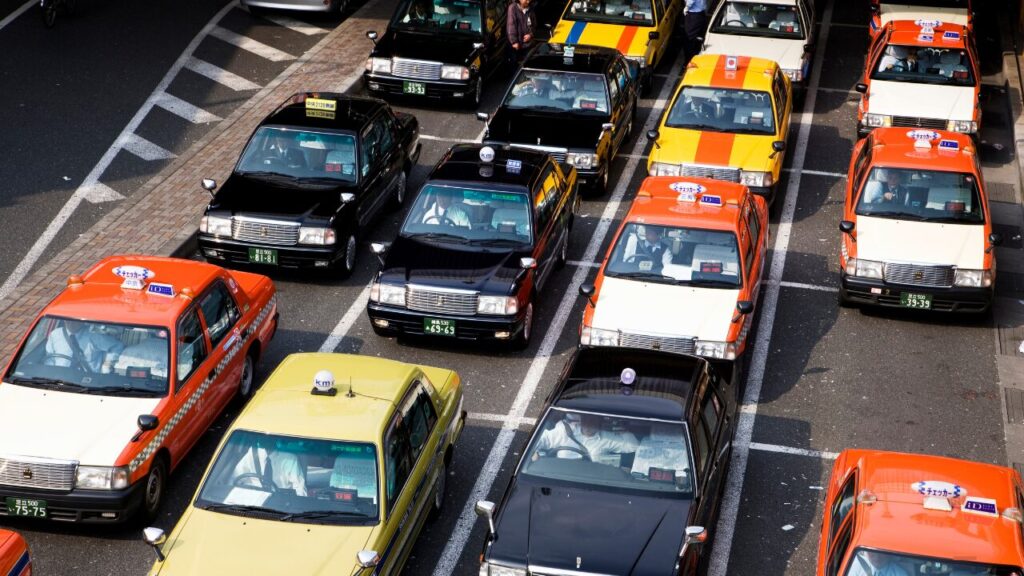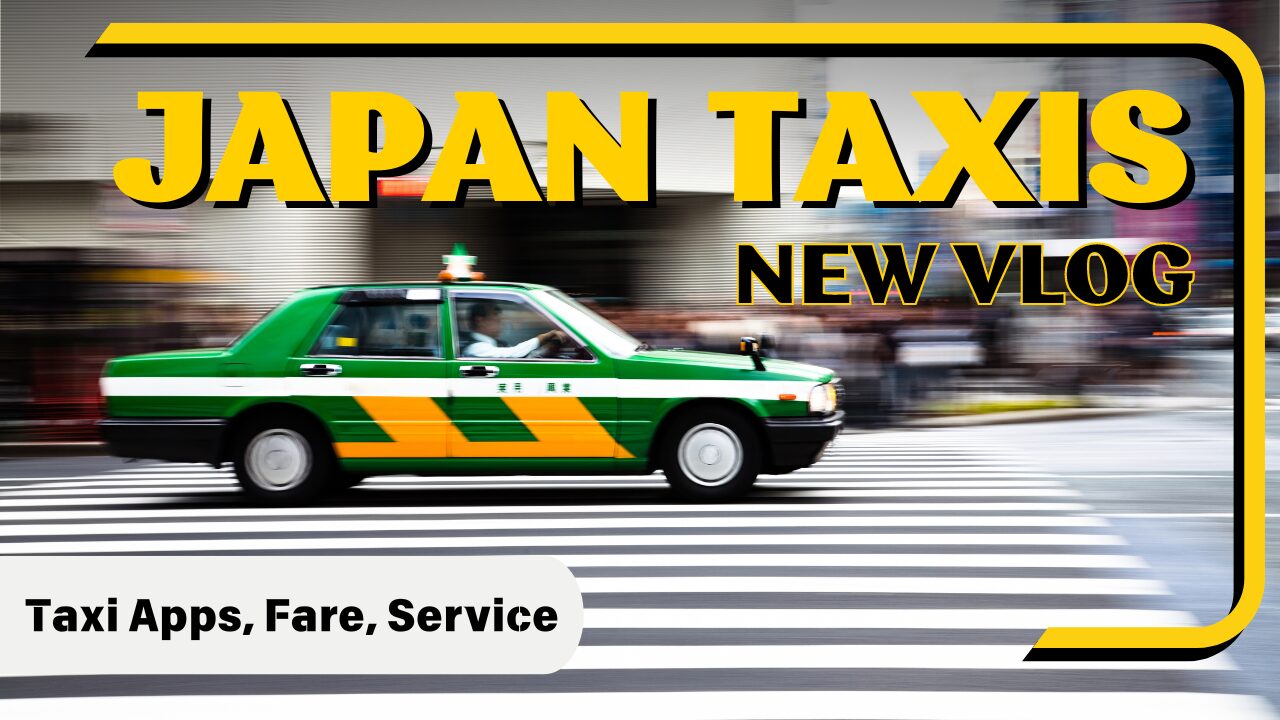
Taxis are available around the world, but the way they are used, the fares, and the apps vary by country.
In this article, we will explain useful information for using taxis in Japan. After reading this article, you’ll be able to ride taxis in Japan without stress!
How to Take a Taxi in Japan

① Stop a Taxi on the Street
Raise your hand so the taxi can see you from the sidewalk!
When you’re in a hurry or caught in a sudden rain, it’s common to flag down a taxi on the street. Be sure to avoid pedestrian crossings and intersections as this can cause traffic disruptions. You can also use taxis that are waiting at stations or hotels.
② Reserve a Taxi by Phone
Many people want to reserve a taxi in advance for their return trip, but only a few taxi companies offer English-language phone services. Here are some of them. If you’re unable to connect, it’s a good idea to ask your hotel to assist you.
③ Using an App
There are various taxi-hailing apps available in Japan, but here we introduce three apps that are particularly popular among foreign visitors.
The taxi-hailing app “Uber” is available in 63 countries and 450 cities worldwide as of April 2024, and can of course be used in Japan as well. In Tokyo, you can even use the more luxurious “Uber Premium.”
Coverage Areas (as of August 2024)
Hokkaido, Aomori, Miyagi, Fukushima, Ishikawa, Tokyo, Kanagawa, Chiba, Osaka, Aichi, Kyoto, Hyogo, Awaji Island, Kochi, Hiroshima, Fukuoka, Okinawa
GO is a taxi-hailing service newly established in 2020. It was created by merging two apps: “MOV” and “JapanTaxi,” which allowed users to specify taxi types and covered all 47 prefectures in Japan.
Coverage Areas (as of August 2024)
Hokkaido, Aomori, Iwate, Akita, Miyagi, Yamagata, Fukushima, Ibaraki, Tochigi, Gunma, Saitama, Chiba, Tokyo, Kanagawa, Niigata, Toyama, Ishikawa, Fukui, Nagano, Shizuoka, Gifu, Aichi, Mie, Shiga, Kyoto, Osaka, Hyogo, Nara, Wakayama, Okayama, Hiroshima, Yamaguchi, Kagawa, Tokushima, Ehime, Kochi, Fukuoka, Saga, Nagasaki, Kumamoto, Miyazaki, Kagoshima
S.RIDE is a taxi-hailing and payment service offered by S.RIDE Co., Ltd. since April 16, 2019, in the Tokyo metropolitan area. The service is currently available in major cities such as Tokyo, Kanagawa, Saitama, and Nagoya, with its coverage areas rapidly expanding.
Coverage Areas (as of August 2024)
Tokyo’s 23 wards, Mitaka City, Musashino City, Saitama, Kanagawa, Chiba, Ibaraki, Aichi, Osaka, Miyazaki
Taxi Fares

Japanese taxi companies strictly comply with regulations, and because the companies properly manage their drivers, illegal activities like those mentioned above are extremely rare. However, it’s not entirely impossible. To avoid being overcharged, it’s helpful to understand how taxi fares are calculated in Japan. If you’re still concerned, you can use a taxi app or ask your hotel to check the fare and book a taxi for you. For airport transfers or full-day sightseeing trips, fixed fares are often available.
Example of Taxi Fares in Tokyo’s 23 Wards
Standard vehicle:
Distance-based fare:
- Initial fare: 500 yen for the first 1,096 meters.
- Additional fare: 100 yen for every 255 meters thereafter.
Time-distance fare:
- 100 yen is added for every 1 minute 35 seconds.
How to Pay Taxi Fares
1.Cash (Japanese Yen)
You can pay in Japanese yen. Since the driver may not have enough change, they would appreciate it if you use 1,000 yen bills or coins, rather than just 10,000 yen bills.
2.Credit Card
Many taxis accept credit cards such as VISA, MasterCard, American Express, JCB, and Diners Club.
3.QR Code Payment
QR code payment services such as Alipay, WeChat Pay, and PayPay are also supported.
4.Transit IC Cards
Transit IC cards like Suica and PASMO are also accepted.
Types of Taxis & Usage

Until around 2010, Japanese taxis were mostly sedans like the Toyota Crown and Nissan Cedric. Recently, dedicated taxi vehicles like the JPN Taxi, as well as larger vehicles like the Alphard, which can accommodate more passengers, have become available.
While the basic fare is the same for sedans and Alphards, many companies charge an additional vehicle selection fee of 2,000 to 3,000 yen if you specify a particular vehicle.
What is a Maternity Taxi in Japan?

By registering your pick-up location, delivery hospital, and due date with the taxi company in advance, you can call a maternity taxi with just one phone call in case of sudden labor. Although it’s possible to use a regular taxi, there are risks such as the inability to safely transport the mother, or being refused service due to the risk of water breaking and dirtying the car. Maternity taxis are prepared specifically for transporting expectant mothers and will reliably take you to your registered hospital, allowing you to use the service with peace of mind.
Ride-sharing Has Also Started

Ride-sharing is a service where private drivers transport passengers for a fee using their personal vehicles. In April 2024, a “Japanese-style ride-share” service, operated by taxi companies, was launched in Japan. The aim is to address vehicle shortages in regions with high inbound demand and to fill transportation gaps during times and days when taxis are hard to find. However, as of August 2024, the service is limited to certain regions and time slots, so it’s not yet widely adopted.





COMMENT